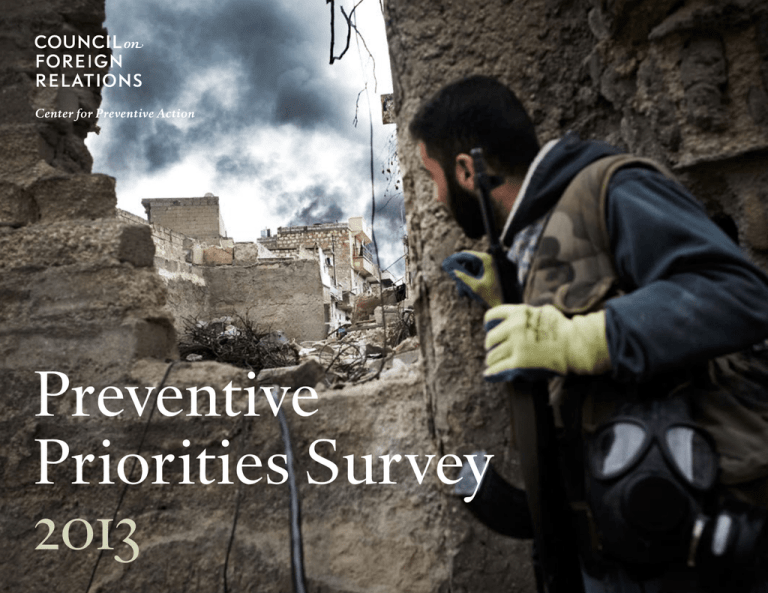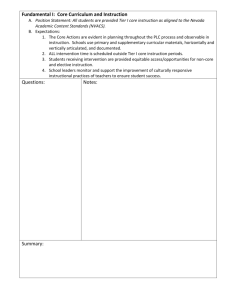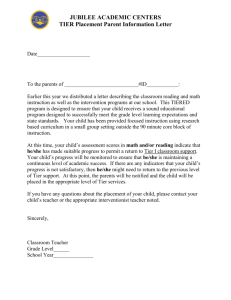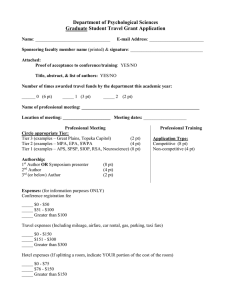
Preventive
Priorities Survey
2013
i
The Council on Foreign Relations acknowledges Carnegie Corporation for its generous support of the
Preventive Priorities Survey.
Copyright © 2012 by the Council on Foreign Relations®, Inc. All rights reserved. Printed in the United States
of America.
This publication may not be reproduced in whole or in part, in any form beyond the reproduction permitted
by Sections 107 and 108 of the U.S. Copyright Law Act (17 U.S.C. Sections 107 and 108) and excerpts by
reviewers for the public press, without express written permission from the Council on Foreign Relations.
Paul B. Stares
Director, Center for Preventive Action
Andrew C. Miller
Research Associate, Center for Preventive Action
Preventive
Priorities Survey
2013
The Center for Preventive Action’s annual Preventive Priorities Survey (PPS) evaluates ongoing and potential violent conflicts based on the impact they could have
on U.S. interests and their likelihood of occurring in the coming year. Policymakers
have limited time and resources for preventive action and thus have to focus on a
select number of potentially harmful contingencies from a myriad of possibilities.
The PPS polls experts in the field and aims to help the U.S. policy community
prioritize these competing conflict prevention and mitigation demands.
Tier I (High Priority)
Tier II (Mid-level Priority)
Tier III (Low Priority)
View the interactive 2013 Preventive
Priorities Survey online at
cfr.org/preventive_priorities_survey
About the PPS Process
Preventing the outbreak of violent conflict in the world
and mitigating its harmful consequences when it does have
long been primary goals of U.S. foreign and security policy.
Some potential sources of conflict appear more likely than
others and understandably grab attention because of that.
The same also applies to the potential escalation of ongoing
conflicts. Yet they cannot all be considered equally consequential—both in terms of their overall cost and, moreover,
their harmful impact on U.S. interests. Given finite resources
and competing demands at home, U.S. policymakers must
make choices about where to devote their attention. In short,
they have to prioritize their conflict prevention and mitigation objectives in ways that rationally balance the competing
imperatives of urgency and importance.
The Preventive Priorities Survey seeks to help policymakers choose among these competing demands by offering
what is essentially an assessment of future risk based on
expert opinion. Risk in this context is defined as the product
of the perceived likelihood of a conflict erupting or escalating and the perceived impact it would likely have on U.S.
interests according to defined criteria. The PPS, therefore,
is not a predictive exercise or tool. Prediction, not least of
violent instability and conflict with all its many complexities,
is beyond anyone’s power. Unpredictable, however, is not the
same as unforeseeable. Estimates of the relative likelihood
of a conflict erupting or escalating can be made on the basis
of identifying the presence and interaction of known risk
factors and projecting how they could plausibly evolve in
unwelcome ways.
Neither is the PPS a prescriptive exercise or tool. Estimating the potential impact of a conflict on U.S. interests
requires not only assessing possible costs (and, to be fair,
opportunities), which is hard to do given the uncertain trajectory of events, but also making judgments about what
constitutes the “national interest.” For all the regularity in
which the national interest is invoked in public debates, there
are no clear or generally accepted criteria for assessing the
relative importance of different interests or values that fall
under this term. The criteria used here are thus subjective.
Conflicts that could directly harm the lives or livelihoods
of Americans rank higher than conflicts that would not.
The same also applies to countries already identified as in
the U.S. interest to protect—especially those where sizable
contingents of U.S. forces are deployed and potentially in
harm’s way—versus others that are not classified as allies
or considered to be strategically important for some reason.
Finally, the PPS represents a snapshot of expert opinion
at the time the survey was conducted in November 2012.
The world is a dynamic place and assessments of risk change
accordingly—at least they should. The results, therefore,
could be quite different several months hence.
3
Methodology
The Center for Preventive Action (CPA) carried out the 2013 PPS in three stages:
Threat Matrix
1. Solicited suggestions from experts and the broader public to develop a list of thirty contingencies for the survey.
CPA’s in-house experts, in consultation with forecasting specialists and Council on Foreign Relations fellows,
identified contingencies to include on the survey that met two broad criteria: plausibility of occurring in 2013
and potential to harm U.S. interests. For the first time, CPA also asked the broader public to proffer suggestions on social media platforms (Facebook, Twitter, Quora, and others). Casting a wide net helped identify
potential outbreaks of violence that may not have received due attention from the media and expert community. From the hundreds of suggestions received, CPA narrowed the list to thirty contingencies of sufficient
clarity and plausibility to warrant inclusion on the survey.
impact on u.s . i nt er ests
Tier I
Tier II
Low
Likely
Moderate
Unlikely
Plausible
l ik el ihood
2. Surveyed a wide cross-section of foreign policy experts to assess the potential impact and likelihood of each contingency. The survey was sent to more than fifteen hundred government officials, academics, and forecasting
experts. Whereas in previous PPS iterations, respondents ranked the thirty contingencies solely based on
their potential impact, this year’s survey also asked the respondents to assess the contingencies’ likelihood of
occurring in 2013. They were also invited to identify contingencies that did not appear on the survey but that
they felt policymakers should consider nonetheless.
3. Assigned each contingency to one of three tiers based on its potential impact and likelihood. The survey results
informed CPA’s placement of the contingencies into their tier rankings, with those appearing in Tier I judged
the highest preventive priorities for U.S. policymakers. Tier II contingencies have a combined impact and likelihood ranking below Tier I and are thus deemed mid-level priorities. Low-priority contingencies fall in Tier
III, according to the PPS rubric. Despite their placement in the lowest tier, policymakers should not ignore
these threats altogether, as they could still have meaningful consequences—humanitarian or otherwise.
High
Tier III
Definitions
i mpact on u.s . i nt er ests
■
■
■
High: contingency directly threatens the U.S. homeland, is
likely to trigger U.S. military involvement because of treaty
commitments, or threatens the supplies of critical U.S. strategic resources
Moderate: contingency affects countries of strategic importance to the United States but do not involve a mutualdefense treaty commitment
Low: contingency could have severe/widespread humanitarian consequences but in countries of limited strategic
importance to the United States
l ik el ihood
■
Likely: contingency will likely occur in 2013
■
Plausible: contingency will plausibly occur in 2013
■
Unlikely: contingency is unlikely to occur in 2013
2013 Findings
There are some notable differences between the 2013 and
2012 PPS results. Last year, an outbreak of widespread
civil violence in Syria was judged a Tier II (i.e., mid-level)
preventive priority for the United States. This year, the
intensification of Syria’s civil war, including possible limited intervention, is considered not only a “high impact”
threat but also “likely” to occur, making it not only a Tier
I contingency but also the highest-ranked priority on the
survey. The possibility of nonstate actors—militia groups
or terrorist organizations—acquiring biological or chemical weapons from Syria’s stockpiles also emerged this
year as a Tier I concern, reflecting recent media reports
and official U.S. warnings.
Many of last year’s Tier I contingencies remained high
preventive priorities. These include the possibility of a
military incident involving the United States or one of
its allies and China over various territorial disputes in
East Asia, a mass casualty terrorist attack on the U.S.
homeland or treaty ally, a highly disruptive cyberattack,
intensification of the Iranian nuclear crisis, and severe
instability in Pakistan. All were judged to be “plausible”
contingencies with the potential of having a “high impact.”
With coalition forces drawing down in Afghanistan, a
major erosion of security in the country was also placed
in Tier I since it was seen as having a “moderate impact”
and “likely” to occur.
Not all Tier I contingencies from last year’s PPS remained in place, however. The possibility of a significant
increase in drug-related conflict in Mexico dropped to
Tier II, most likely in response to promising reports of
abating violence there. Pyongyang’s recent missile launch
notwithstanding, a severe North Korean crisis now also
has a Tier II ranking. At the same time, potential instability in Saudi Arabia had a Tier I ranking on the 2012
PPS in the wake of the Arab Awakening turmoil but has
fallen to Tier III this year. This can be attributed to the
absence of significant popular unrest in Saudi Arabia and
a perceived diminishing U.S. dependence on Persian Gulf
energy supplies.
Many of last year’s Tier II contingencies stayed in
place—notably those relating to Egypt, Yemen, Bahrain,
India, Pakistan, Iraq, and countries with competing claims
to the South China Sea. The possibility of Lebanon being
destabilized by the conflict in neighboring Syria not surprisingly emerged as a new concern. Jordan is also now
considered more vulnerable to popular political unrest.
Meanwhile, three African contingencies were elevated
from Tier III to Tier II priorities: increased political instability in Nigeria, deepening violence in the Democratic
Republic of the Congo, and the potential emergence of
Libya as a terrorist safe haven.
Many of the Tier III contingencies this year are familiar
from the 2012 survey. These include continuing friction
between Sudan and South Sudan, military clashes between Armenia and Azerbaijan, the possibility of violence
around the 2013 presidential election in Kenya, and unrest in Zimbabwe, also related to planned elections or the
possible death of Robert Mugabe. The potential for Mali
to further deteriorate as a result of a failed intervention,
growing instability in Sudan, and renewed unrest in the
Kurdish-dominated regions of Turkey and the Middle
East emerged as new Tier III concerns.
Since the survey was limited to thirty contingencies,
respondents had the opportunity to add other potential
crises that they thought warranted attention. Those worthy of mention include the outbreak of a third Palestinian
intifada, widespread popular unrest in China, escalation
of a U.S.-Iran naval clash in the Persian Gulf, a SinoIndian border crisis, onset of elections-related instability
and violence in Ethiopia, unrest in Cuba following the
death of Fidel Castro and/or incapacitation of Raul Castro, and widespread political unrest in Venezuela triggered
by the death or incapacitation of Hugo Chavez.
5
Tier I
Contingencies judged high preventive
priorities for U.S. policymakers
i mpact: high
l ik el ihood: l ik ely
■
intensification of Syria’s civil war,
including possible limited external
intervention
i mpact: high
l ik el ihood: pl ausibl e
■
■
■
■
■
■
an Iranian nuclear crisis such as a surprise advance in Iran’s nuclear weapons/delivery capability followed by an
Israeli response
a major military incident with China
involving U.S. or allied forces such as a
Sino-Japanese clash over the Senkaku/
Diaoyu Islands
a mass casualty attack on the U.S.
homeland or on a treaty ally
nonstate actors acquire biological or
chemical weapons from stockpiles in
Syria
CHINA
severe internal instability in Pakistan,
triggered by a civil-military crisis or
terror attacks
SYRIA
a highly disruptive cyberattack on U.S.
critical infrastructure
impact: moder at e
l ik el ihood: l ik ely
■
UNITED STATES
a major erosion of security in Afghanistan resulting from coalition drawdown
PAKISTAN
AFGHANISTAN
IRAN
Tier II
Contingencies judged mid-level preventive priorities for U.S. policymakers
impact: moder at e
l ik el ihood: pl ausibl e
■
■
■
■
■
■
■
■
a severe Indo-Pakistan crisis that carries
risk of military escalation, triggered by a
major terror attack
a severe North Korean crisis caused by
another military provocation, internal
political instability, or threatening nuclear
weapons/ICBM-related activities
a significant increase in drug trafficking
violence in Mexico that spills over into
the United States
a South China Sea armed confrontation
over competing territorial claims
IRAQ
LEBANON
JORDAN
EQYPT
LIBYA
NIGERIA
continuing political instability and emergence of a terrorist safe haven in Libya further deterioration of security and/or
backlash against counterterrorism operations expands al-Qaeda in the Arabian
Peninsula safe haven in Yemen
MEXICO
growing instability in Bahrain that spurs
violent government reprisals or further
Saudi and/or Iranian military action
impact: high
l ik el ihood: u nl ik ely
increasing sectarian violence and heightened political instability in Nigeria
■
■
■
■
■
renewed sectarian violence in Lebanon
due to spillover from the conflict in Syria
rising sectarian violence and growing
secessionist pressures in Iraq
widespread popular protests in Jordan
triggered by dissatisfaction with the pace
of political reform
unrest in Egypt over pace of reforms and
deteriorating economic conditions
NORTH KOREA
CHINA
INDIA
PAKISTAN
DEMOCRATIC REPUBLIC
OF THE CONGO
BAHRAIN
YEMEN
VIETNAM
PHILLIPINES
MALAYSIA
BRUNEI
INDONESIA
a U.S.-Pakistan military confrontation,
triggered by a terror attack or U.S.
counterterror operations
impact: low
l ik el ihood: l ik ely
■
a deepening of violence in the eastern
Democratic Republic of the Congo
that involves military intervention from
its neighbors
7
Tier III
Contingencies judged low preventive
priorities for U.S. policymakers
impact: low
l ik el ihood: pl ausibl e
■
■
■
■
growing popular unrest and political
instability in Sudan
military conflict between Sudan and
South Sudan
renewed ethnic violence in Kenya
surrounding March 2013 presidential
election
widespread unrest in Zimbabwe surrounding the electoral process and/or
the death of Robert Mugabe
AZERBAIJAN
ARMENIA
TURKEY
impact: moder at e
l ik el ihood: u nl ik ely
■
■
political instability in Saudi Arabia that
endangers global oil supplies
renewed unrest in the Kurdish-dominated
regions of Turkey and the Middle East
impact: low
l ik el ihood: u nl ik ely
■
■
an outbreak of military conflict between
Armenia and Azerbaijan, possibly over
Nagorno-Karabakh
failure of a multilateral intervention to
push out Islamist groups from Mali’s
north
MALI
SAUDI ARABIA
SUDAN
SOUTH SUDAN
KENYA
ZIMBABWE
a bout th e cent er for pr e v enti v e action
The Center for Preventive Action (CPA) seeks to help prevent, defuse, or resolve deadly conflicts around the world
and to expand the body of knowledge on conflict prevention. It does so by creating a forum in which representatives
of governments, international organizations, nongovernmental organizations, corporations, and civil society can
gather to develop operational and timely strategies for promoting peace in specific conflict situations. The center focuses on conflicts in countries or regions that affect U.S. interests, but may be otherwise overlooked; where prevention appears possible; and when the resources of the Council on Foreign Relations can make a difference. The center
does this by
■
■
■
■
Issuing Council Special Reports to evaluate and respond rapidly to developing conflict situations and formulate
timely, concrete policy recommendations that the U.S. government, international community, and local actors can
use to limit the potential for deadly violence.
Engaging the U.S. government and news media in conflict prevention efforts. CPA staff members meet with administration officials and members of Congress to brief on CPA’s findings and recommendations; facilitate contacts
between U.S. officials and important local and external actors; and raise awareness among journalists of potential
flashpoints around the globe.
Building networks with international organizations and institutions to complement and leverage the Council’s
established influence in the U.S. policy arena and increase the impact of CPA’s recommendations.
Providing a source of expertise on conflict prevention to include research, case studies, and lessons learned from
past conflicts that policymakers and private citizens can use to prevent or mitigate future deadly conflicts.
For more information, to sign up for the CPA enewsletter, or to access the Center for Preventive Action’s latest work,
please visit www.cfr.org/cpa. CPA is on Facebook: www.facebook.com/CFRCenterForPreventiveAction.
a bout th e cou ncil on for eign r el ations
The Council on Foreign Relations (CFR) is an independent, nonpartisan membership organization, think tank, and
publisher dedicated to being a resource for its members, government officials, business executives, journalists, educators and students, civic and religious leaders, and other interested citizens in order to help them better understand
the world and the foreign policy choices facing the United States and other countries.
The Council on Foreign Relations takes no institutional positions on policy issues and has no affiliation with the
U.S. government. All statements of fact and expressions of opinion contained in its publications and on its website
are the sole responsibility of the author or authors.
For further information about CFR or this publication, please write to the Council on Foreign Relations,
58 East 68th Street, New York, NY 10065, or call Communications at 212.434.9888. Visit CFR’s website, CFR.org.
9
Cover photo: During the Eid al-Adha Muslim holiday, a
member of the Free Syrian Army observes the damage
caused by an enemy tank around Saknt Hanano, a
regime military base and the center of the latest fighting
in Aleppo, Syria, on October 26, 2012 (Sebastiano
Tomada/Sipa USA/AP images).
Council on Foreign Relations
58 East 68th Street
New York, NY 10065
tel212.434.9400
fax212.434.9800
1777 F Street, NW
Washington, DC 20006
tel202.509.8400
fax202.509.8490
www.cfr.org



